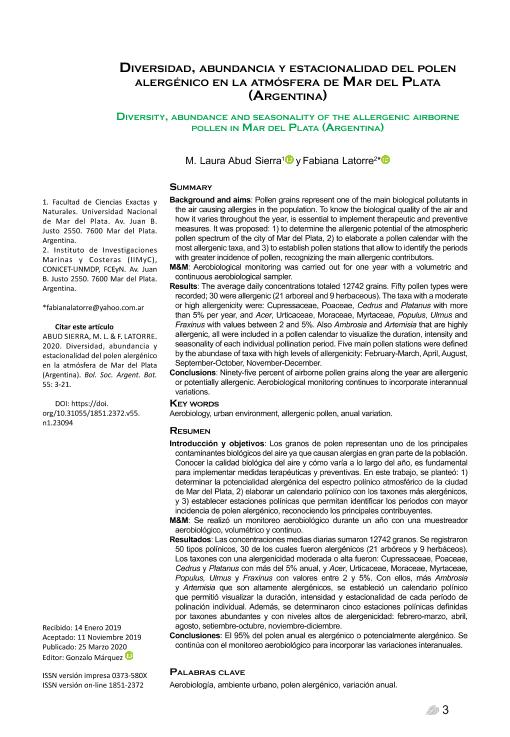Artículo
Introducción y objetivos: Los granos de polen representan uno de los principales contaminantes biológicos del aire ya que causan alergias en gran parte de la población. Conocer la calidad biológica del aire y cómo varía a lo largo del año, es fundamental para implementar medidas terapéuticas y preventivas. En este trabajo, se planteó: 1) determinar la potencialidad alergénica del espectro polínico atmosférico de la ciudad de Mar del Plata, 2) elaborar un calendario polínico con los taxones más alergénicos, y 3) establecer estaciones polínicas que permitan identificar los periodos con mayor incidencia de polen alergénico, reconociendo los principales contribuyentes. M&M: Se realizó un monitoreo aerobiológico durante un año con una muestreador aerobiológico, volumétrico y continuo. Resultados: Las concentraciones medias diarias sumaron 12742 granos. Se registraron 50 tipos polínicos, 30 de los cuales fueron alergénicos (21 arbóreos y 9 herbáceos). Los taxones con una alergenicidad moderada o alta fueron: Cupressaceae, Poaceae, Cedrus y Platanus con más del 5% anual, y Acer, Urticaceae, Moraceae, Myrtaceae, Populus, Ulmus y Fraxinus con valores entre 2 y 5%. Con ellos, más Ambrosia y Artemisia que son altamente alergénicos, se estableci un calendario polínico que permitió visualizar la duración, intensidad y estacionalidad de cada período de polinación individual. Además, se determinaron cinco estaciones polínicas definidas por taxones abundantes y con niveles altos de alergenicidad: febrero-marzo, abril, agosto, setiembre-octubre, noviembre-diciembre. Conclusiones: El 95% del polen anual es alergénico o potencialmente alergénico. Se continúa con el monitoreo aerobiológico para incorporar las variaciones interanuales. Background and aims: Pollen grains represent one of the main biological pollutants in the air causing allergies in the population. To know the biological quality of the air and how it varies throughout the year, is essential to implement therapeutic and preventive measures. It was proposed: 1) to determine the allergenic potential of the atmospheric pollen spectrum of the city of Mar del Plata, 2) to elaborate a pollen calendar with the most allergenic taxa, and 3) to establish pollen stations that allow to identify the periods with greater incidence of pollen, recognizing the main allergenic contributors. M&M: Aerobiological monitoring was carried out for one year with a volumetric and continuous aerobiological sampler. Results: The average daily concentrations totaled 12742 grains. Fifty pollen types were recorded; 30 were allergenic (21 arboreal and 9 herbaceous). The taxa with a moderate or high allergenicity were: Cupressaceae, Poaceae, Cedrus and Platanus with more than 5% per year, and Acer, Urticaceae, Moraceae, Myrtaceae, Populus, Ulmus and Fraxinus with values between 2 and 5%. Also Ambrosia and Artemisia that are highly allergenic, all were included in a pollen calendar to visualize the duration, intensity and seasonality of each individual pollination period. Five main pollen stations were defined by the abundase of taxa with high levels of allergenicity: February-March, April, August, September-October, November-December. Conclusions: Ninety-five percent of airborne pollen grains along the year are allergenic or potentially allergenic. Aerobiological monitoring continues to incorporate interannual variations.
Diversidad, abundancia y estacionalidad del polen alergénico en la atmósfera de Mar del Plata (Argentina)
Título:
Diversity, abundance and seasonality of the allergenic airborne pollen in Mar del Plata (Argentina)
Fecha de publicación:
03/2020
Editorial:
Sociedad Argentina de Botánica
Revista:
Boletín de la Sociedad Argentina de Botánica
ISSN:
1851-2372
Idioma:
Español
Tipo de recurso:
Artículo publicado
Clasificación temática:
Resumen
Palabras clave:
POLEN
,
Alergias
,
Urbano
,
Atmosfera
Archivos asociados
Licencia
Identificadores
Colecciones
Articulos(IIMYC)
Articulos de INSTITUTO DE INVESTIGACIONES MARINAS Y COSTERAS
Articulos de INSTITUTO DE INVESTIGACIONES MARINAS Y COSTERAS
Citación
Abud Sierra, Maria Laura; Latorre, Fabiana; Diversidad, abundancia y estacionalidad del polen alergénico en la atmósfera de Mar del Plata (Argentina); Sociedad Argentina de Botánica; Boletín de la Sociedad Argentina de Botánica; 55; 1; 3-2020; 3-21
Compartir
Altmétricas




